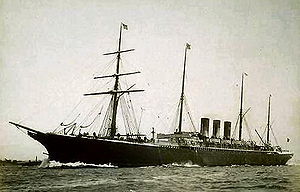SS City of Rome
 Inman's City of Rome | |
| Career (UK) | |
|---|---|
| Name: | City of Rome |
| Owner: | Inman Line |
| Route: | Atlantic crossing. |
| Builder: | Barrow |
| Commissioned: | 1881 |
| Fate: | Scrapped 1902 |
| General characteristics | |
| Type: | Steamship |
| Tonnage: | 8400 tons |
| Length: | 560 feet (170 m) |
| Beam: | 52 feet (16 m) |
| Sail plan: | 4 masts |
City of Rome was a British passenger liner of the Inman Line that was designed to be the largest and fastest liner on the Atlantic. While often regarded as the most beautiful liner to ever cross the Western Ocean, she proved to be a major disappointment and was returned to her builders after only six voyages. Barrow transferred City of Rome to the Anchor Line which operated her on various routes until she was scrapped in 1902.[1]
Development and design
The completion of Guion's Arizona in 1879 forced all of the major Atlantic companies to consider building new greyhounds. Inman's answer was a much larger ship designed to cross the Atlantic at 18 knots. City of Rome carried 520 First Class passengers in quarters of especially high quality along with 810 stearage. She was also one of the first liners lit entirely by electricity.[1]
The contract called for a steel hull, but the builder, Barrows, convinced Inman to accept iron because of difficulties in securing sufficient supplies of the then relatively new metal. Twin screws were at one point contemplated but rejected. The machinery consisted of three sets of inverted tandems and delivered only 75% of designed horsepower. City of Rome also drew too much water because of inadequate calculations when iron was substituted for steel. As a result, she reached just 15.75 knots on trial. Her cargo capacity was also only 2,200 tons, instead of the 3,800 tons specified.[1]
Service history
In August 1882, Inman rejected City of Rome after only six voyages brcause of her inadequate performance. Burrows lost the lengthly litigation that followed. The Anchor Line was associated with Barrows and was given the responsibility to operate Barrow's white elephant. After Barrows modified the machinery and reduced weight, City of Rome reached 18.25 knots on new trials. Starting in May 1883, Anchor placed her on the Liverpool-New York route where she proved comfortable and popular, but unprofitable because she lacked a suitable consort. Various attempts were made to overcome this difficulty, including pairing City of Rome with the National Line's America in 1886, but none of these arrangements proved satisfactory.[1]
In 1891, City of Rome was withdrawn from Liverpool and moved to the Glasgow-New York route, paired with vessels half her size. Her accommodations were now 75 First, 250 Second and 1,000 stearage. In September 1898, City of Rome was chartered to repatriate Spanish naval POWs captured by the United States. In 1899, she was damaged in a collision with an iceberg. The following year, she was employed as a troopship for the Boer War. At the end of this duty, City of Rome was sold to a German scrap firm.[1]
References
